Hamilcar Barca › Colossi of Memnon » Ancient origins
Articles and Definitions › Contents
- Hamilcar Barca › Who Was
- Colossi of Memnon › Antique Origins
Ancient civilizations › Historical and archaeological sites
Hamilcar Barca › Who Was
Definition and Origins

Hamilcar Barca (c. 285 – c. 228 BCE) was a Carthaginian general active in the First Punic War (264-241 BCE). He then quashed a rebellion closer to home between 241 and 237 BCE before returning abroad, where he successfully expanded Carthaginian interests in southern Spain. In these conflicts, Hamilcar had switched Carthage from a naval power to a land power with great success, and he firmly established the Barcid family as the ruling house of Carthage. He was the father of Hannibal Barca who continued his father's tactics and won major land battles in Italy during the Second Punic War.
NAME & FAMILY
'Hamilcar', from the Punic hml-qrt, means follower or servant of Melqart, the Phoenician/Punic god whilst 'Barca' is thought to derive from the Punic word barqa, meaning lightning, and was used in reference to Hamilcar's guerrilla tactics used in the First Punic War.
Hamilcar Barca was a member of the Barcid clan of Carthage and the father of Hannibal Barca, Rome ’s most notorious enemy, who crossed the Alps and caused havoc in Italy in the Second Punic War (218 - 201 BCE). In 237 BCE Hamilcar had famously taken his son, then nine years old, to the temple of Baal in Carthage and made him swear never to be a friend of Rome. Hamilcar's other two sons were Hasdrubal Barca and Hasdrubal Gisco, both of whom commanded during the Second Punic War.
HAMILCAR & THE BARCID LINE WOULD DOMINATE THE CARTHAGINIAN POLITICAL & MILITARY ARENAS FOR THE NEXT 35 YEARS.
FIRST PUNIC WAR
After 15 years of fighting, there was still no end in sight to the Second Punic War. Carthage had beaten a Roman army in Africa, but Rome seemed able to replace their naval fleets at will. Sicily had been the principal battleground but had yet to see a decisive victory for either side. Then the enterprising Hamilcar Barca came to the fore. He replaced Carthalo, who had not been altogether unsuccessful, as the commander of the Carthaginian fleet.
Hamilcar first raided the Italian coast at Bruttium in 247 BCE, perhaps in search of booty to pay his mercenaries, and then landed on Sicily at Heircte near Panormus (Palermo). This position allowed Hamilcar to hold a mountain base and harass the rear of the Roman forces who were besieging Drepana and Lilybaeum, which were Carthage's last remaining strongholds on Sicily. The Romans responded by blockading Hamilcar, but he seems to have been able to break out regularly and continue his guerrilla tactics. As Carthage no longer had the resources for a large army, he could not face the enemy in an all-out battle, but he did manage to capture Eryx in 244 BCE, which became his new base. This turned out to further restrict his freedom of movement, but the Carthaginian commander continued to coordinate attacks on the Italian mainland, perhaps as north as Cumae. Still, without a significant force at his disposal (fewer than 20,000 men) and despite Polybius ' praise that he was the best Carthaginian general of the war, Hamilcar's effect on the conflict was ultimately a limited one.

Roman Beach Attack
The end finally came on 10th March 241 BCE when the Romans defeated a Carthaginian fleet led by Hanno sent to relieve the besieged city of Drepana off the Aegates Islands (Isole Egadi). 50 Carthaginian ships were sunk, 70 captured and 10,000 prisoners taken. This loss was not huge, but after decades of war, it drove the cash-strapped Carthaginians to instruct Hamilcar to seek peace terms. Hamilcar then resigned his command but he would be needed again within months.
THE TRUCELESS WAR
Not only did the Carthaginians lose the First Punic War and so the control of Sicily but they were also compelled to pay huge reparations to Rome. Then the so-called Truceless War (also Mercenary War) broke out in 241 BCE. Carthage faced a joint rebellion of mercenary troops, understandably upset at not having been paid for their efforts in the first Punic War, Libyan groups seizing the opportunity of a weakened Carthage to rebel, and several cities looking for independence such as Tunis and Utica. Hamilcar Barca was recalled from Sicily and he joined Hanno the Great, who had made significant conquests in Libya while Hamilcar had been in Sicily, to quash the rebellion. First, Hamilcar broke the rebel siege of Carthage and then defeated an army led by Spendius near the Bagradas River. Hamilcar had managed to persuade the Numidian prince Naravas to defect with his cavalry force to the Carthaginian side, lured by the promise of Hamilcar's daughter for his wife. Hamilcar now had an army of 12,000 and 70 elephants with which to face the rebels.
Elsewhere, things did not go so well. Hippacra and Utica were both besieged, and Hanno was unable to free them. In 239 BCE a mercenary force took control of Sardinia and then defeated a Carthaginian army sent to re-take the island. In the same year, both Hippacra and Utica joined the rebels. The war was now becoming particularly brutal with atrocities committed on both sides. The rebels mutilated prisoners, and Hamilcar had his captives trampled on by elephants. Long-time rivals Hamilcar and Hanno could not agree on the best strategy and eventually the army was permitted to choose which general should lead them. They chose Hamilcar.
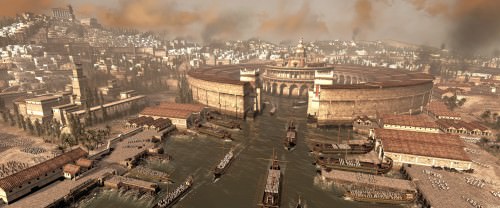
Carthage and its Harbour
The war started to improve for Carthage when they were aided by Rome, who repatriated captured Carthaginian soldiers for free, and the tyrant of Syracuse Hiero, who feared that without Carthage then Rome might act at will in the central Mediterranean. Hamilcar broke off the second siege of Carthage by Mathos and headed inland where a rebel army awaited him. There, after several skirmishes, Hamilcar cornered the enemy at 'the Saw' (Prion), a ridge in the Libyan mountains. The rebel army was starved of supplies and eventually sought to surrender. Hamilcar refused and slaughtered all of them except for the commanders. These were taken to Tunis, the rebel capital, and crucified in full sight of Mathos' army. Meanwhile, Mathos had defeated a Carthaginian army, and he dealt the same treatment to the captured Carthaginian general. Mathos could not, though, resist a joint army of Hamilcar and Hanno, and he was driven out of the city and defeated at Byzacium.Finally, with the fall of the rebel capital in 237 BCE, Hippacra and Utica back on the Carthaginian side, and Libya now compliant, Carthage had regained control of its African empire. Hamilcar and the Barcid line would now dominate the Carthaginian political and military arenas for the next 35 years.
HAMILCAR IN SPAIN
Carthage was on the rise again and eager to create a wider Mediterranean empire. Without a significant fleet and having lost their strategically important fortresses in Sicily, Corsica and Sardinia, the Carthaginians, though, had to look elsewhere for a source of money to fund their armies. The answer was Spain. They had long since had control of the old Phoenician colonies there, and it had already proven a rich source of silver. Accordingly, Hamilcar Barca was dispatched in 237 BCE to expand Carthaginian territory, which he did, establishing his base at Gades ( Cadiz ) and founding a new city of Acra Leuce. He supplemented his original force of some 25,000 with local recruits and amassed a 50,000-strong army which included a corps of Numidian cavalry (supplied by Prince Naravas) and 100 elephants. Using a blend of terror and diplomacy Hamilcar relentlessly expanded his control over southern Spain. The riches from these campaigns were channelled back to Carthage.Hamilcar's move away from the traditional naval power of Carthage to a land force was reaping fantastic rewards.
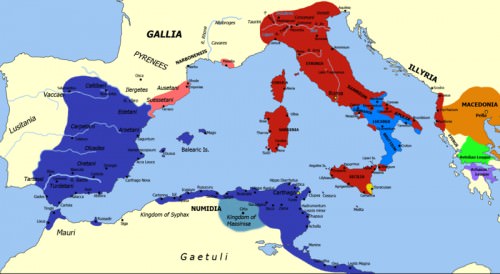
Territories During the Second Punic War
By the time Hamilcar had conquered southern and south-east Spain, Rome became suspicious of their old enemy's intentions.Envoys were sent to Hamilcar demanding an explanation. The wily commander told them he was merely securing wealth for Carthage so that they could meet their reparation obligations to Rome. Certainly, tribute in money, if not men, was extracted from local cities and new silver mines were worked. The Carthaginian's, in any case, continued campaigning in Spain. After the siege of Helice and betrayed by local allies, Hamilcar retreated and drowned while crossing a river in the winter of 229/228 BCE. Hasdrubal the Fair then took over command of the Carthaginian army. When he was replaced by Hannibal in 221 BCE, the Carthaginians broke the territorial agreement with Rome of 226 BCE not to cross the River Ebro and attacked Rome's ally Saguntum (Sagunto). This led to the Second Punic War and Hannibal taking the army across the Alps into Italy. Hamilcar had indeed got his wish that the Barcid line would be no friend of Rome.
Colossi of Memnon › Antique Origins
Definition and Origins

The Colossi of Memnon (also known as el-Colossat or el-Salamat) are two monumental statues representing Amenhotep III(1386-1353 BCE) of the 18th Dynasty of Egypt. They are located west of the modern city of Luxor and face east looking toward the Nile River. The statues depict the seated king on a throne ornamented with imagery of his mother, his wife, the god Hapy, and other symbolic engravings. The figures rise 60 ft (18 meters) high and weigh 720 tons each; both carved from single blocks of sandstone.
They were constructed as guardians for Amenhotep III's mortuary complex which once stood behind them. Earthquakes, floods, and the ancient practice of using older monuments and buildings as resource material for new structures all contributed to the disappearance of the enormous complex. Little of it remains today except for the two colossal statues which once stood at its gates.
Their name comes from the Greek hero Memnon who fell at Troy. Memnon was an Ethiopian king who joined the battle on the side of the Trojans against the Greeks and was killed by the Greek champion Achilles. Memnon's courage and skill in battle, however, elevated him to the status of a hero among the Greeks. Greek tourists, seeing the impressive statues, associated them with the legend of Memnon instead of Amenhotep III and this link was also suggested by the 3rd century BCE Egyptian historian Manetho who claimed Memnon and Amenhotep III were the same person.
THE SITE BECAME LEGENDARY FOR DIVINATION AFTER ONE OF THE STATUES BEGAN MAKING NOISES INTERPRETED AS ORACLES.
The Greek writers referred to the entire complex regularly as the Memnonium and the site became legendary for divination after one of the statues began making noises interpreted as oracles. From ancient times to the present the Colossi have been a popular tourist attraction and in the present day one can see graffiti inscribed on the base from visitors thousands of years ago.
AMENHOTEP III & THE GLORY OF EGYPT
Amenhotep III lived during the period of the New Kingdom (c. 1570-c. 1069 BCE) in which Egypt became a country of international power and wealth. His father, Thutmose IV (1400-1390 BCE), left his son a prosperous and stable empire of substantial riches which the new king used wisely. He was only twelve years old when he came to the throne and married Tiye, a girl of only eleven or twelve, who came from a prestigious family. Tiye was given the title of Great Royal Wife, an honor which even Amenhotep III's mother had not been accorded. This title reflects the great status of both Amenhotep III and Tiye as a royal couple of impressive power.

Amenhotep III
In keeping with the traditions of powerful pharaohs, Amenhotep III almost instantly embarked on grand building projects throughout Egypt. His vision was of a land so splendid and opulent that it would leave one in awe and the over 250 buildings, temples, statuaries, and stele he commissioned attest to his success in realizing this. His pleasure palace at Malkata, on the west bank of the Nile near Thebes, covered over 30,000 square meters (30 hectares) and included spacious apartments, conference rooms, audience chambers, a throne room and receiving hall, a festival hall, libraries, gardens, storerooms, kitchens, a harem, and a temple to the god Amun.
AMENHOTEP III COMMISSIONED SO MANY MONUMENTS THAT LATER EGYPTOLOGISTS ATTRIBUTED TO HIM AN EXTRAORDINARILY LONG REIGN.
Amenhotep III commissioned so many monuments, temples, and other building projects that later Egyptologists attributed to him an extraordinarily long reign because it seemed impossible that one king could have had the resources to accomplish what he did in less than 100 years. Amenhotep III, of course, ruled for far less time but was so effective a king that he accomplished far more than most.
He was a master of diplomacy who placed other nations in his debt through lavish gifts to ensure they would be inclined to bend to his wishes. His generosity to friendly kings was well established and he enjoyed profitable relationships with the surrounding nations which filled Egypt's royal treasury. He maintained the honor of Egyptian women in refusing requests to send them as wives to foreign rulers, claiming that no daughter of Egypt had ever been sent to a foreign land and would not be sent under his reign. While other nations may not have felt at all flattered by this policy, it expressed an adherence to tradition and cultural values which won their respect.
Throughout his reign, Amenhotep III improved upon his father's very sound policies of rule and in religion he did likewise.Amenhotep III was an ardent supporter of the ancient religion of Egypt and expressed his interest lavishly in patronage of the arts and in building projects. Among the most opulent was his mortuary temple complex which included the massive figures of the Colossi of Memnon.
THE GRAND MORTUARY COMPLEX
Amenhotep III's mortuary complex was larger and greater in every way than anything previously built in Egypt. At the time of its construction it was more magnificent and awe-inspiring than the Temple of Karnak. It covered over 86 acres (35 hectares) and included numerous rooms, halls, porticos and plateaus which probably mirrored the vision of the Field of Reeds, the Egyptian paradise. In their time, the colossal statues of the king would have flanked a walkway, probably ornamented with statuary, leading to the complex.
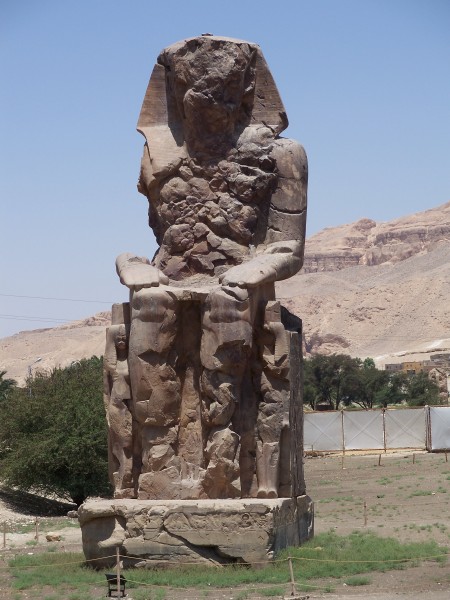
Colossus of Memnon
There was an open sun court adjacent to the temple surrounded by three rows of columns and, on the north and south sides, statues of the king as Osiris in mummified form. This was in keeping with the tradition of kings associating themselves with Horus during their reign and with his father Osiris in death. The statues were 26 feet (8 meters) tall; those on the south side of the court wore the white crown of Upper Egypt while those on the north wore the red crown of Lower Egypt.
The statues of the king symbolized his rule over all Egypt, identified him with Osiris, and made clear the king's wealth and power. Osiris was believed to have been the first king of Egypt and the Lord and Judge of the Dead. Even though kings before and after Amenhotep III associated themselves with Osiris in their mortuary complexes, Amenhotep III made his close relationship with the god both more apparent and more impressive.
Most Egyptians would never have been allowed into the complex to see these statues, the sun court, or anything else but they would have been aware of the great figures who stood at the gates which could be seen for miles from every direction.Egyptologist Gay Robins notes that the statues' function "was to guard the entrance to the complex, to inspire awe at the king's might, and to celebrate the acheivements of the state" (130). Their ability to awe is well established by writers from ancient times to the present owing to their sheer size and the amount of effort it must have taken to create them.
THE GUARDIANS OF THE GATE
The statues were carved from single blocks of quartzite sandstone quarried either from the area around Memphis (near modern-day Cairo) in the north or from the region near Aswan in the south. If quarried from the north, the blocks had to be transported overland 400 miles (645 km) and, if from the south, 147 miles (238 km) as they were too heavy to move by ship on the Nile. How the stones were transported is unknown but they were most likely pushed on sleds in the same way blocks of stone were moved to the site of Giza for construction of the pyramids.

Side Panel, Colossus of Memnon
In their day, the guardians at the gate would have been clear depictions of Amenhotep III as god-king although they have sat in ruin now for centuries and, today, the figures are unrecognizable. He was deified in his lifetime and venerated by his own cult for centuries afterward. The base of the works depict his mother Mutemwiya and wife Tiye on the front and Hapy, the god of the Nile, on the side. All three of these figures symbolized rebirth. Gay Robins comments on the significance of the mother/wife figures:
Together these women represented the combined mother/consort role of the sky goddess through which the sun god renewed himself so that their presence symbolized the king's perpetual renewal through self-regeneration.(130)
Art in ancient Egypt was created to be functional and the Colossi are no exception. The statues would have served not only to guard the complex but, through a kind of sympathetic magic, allow the king to inhabit them and receive strength and sustenance from the symbolic imagery. The figures of Mutemwiya and Tiye are not just honorary ornamentation but served a specific purpose according to Egyptian belief. Mortuary statues placed in tombs were considered homes for the soul of the deceased when it visited earth and needed to be provided with food and drink offerings. In this same way, the Colossi were also thought to be more than simple stone images and especially after one of them began to sing.
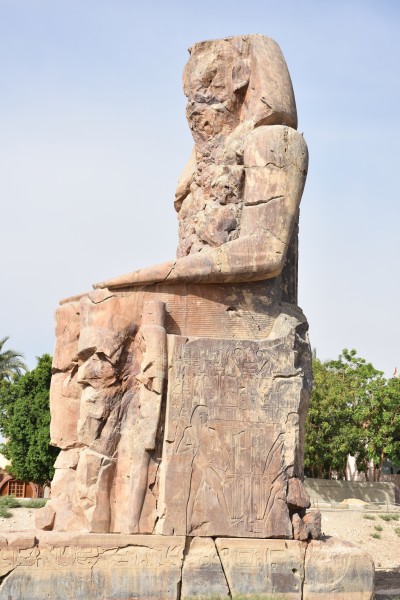
Colossus of Memnon (Side View)
THE SINGING STATUE
The Greek historian Strabo (65 BCE-23 CE) is the first to record the sound which would later be described as singing, the sound of a lyre, brass instruments, a broken harp or lyre string, and a slap or blow. Strabo noted in his Geography that an earthquake shattered the upper part of the northern statue which, thereafter, made the noise every day at dawn. After visiting the site, Strabo writes:
Here are two colossi, which are near one another and are each made of a single stone; one of them is preserved, but the upper parts of the other, from the seat up, fell when an earthquake took place, so it is said. It is believed that once each day a noise, as of a slight blow, emanates from the part of the latter that remains on the throne and its base; and I too, when I was present at the place with Aelius Gallus and his crowd of associates, both friends and soldiers, heard the noise at about the first hour. (XVII.46)
Strabo adds that he cannot be sure where the sound came from, whether the statue itself, the base, or from one of the people standing nearby, but claims he will accept any explanation other than that of the stone image "speaking" in some way.
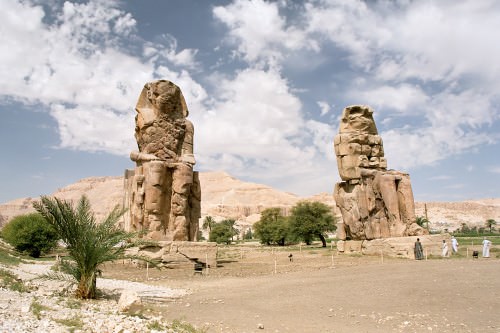
Colossi of Memnon
Many other ancient writers record the singing statue and the graffiti one may still see at the base records whether a visitor heard or did not hear the sound. People from all classes of society and regions traveled to the site for divination purposes, to ask a question and hope for the gods' answer, and would be rewarded - or disappointed - by the experience. This practice continued until the Roman emperor Septimus Severus (193-211 CE) visited in either 196 or 199 CE and did not hear the sound. Hoping to curry favor with the oracle, he had the northern statue repaired; afterwards, the sounds stopped completely.
It is popularly supposed that the sound was caused by dew drying inside the cracks of the statue and the porus rock was simply responding to the oncoming heat of the morning after a cool night. Similar "mysterious" sounds can be heard from objects like guard rails on roads between dawn and mid-morning in the present day.
Severus' repair of the statue sealed the cracks of the upper body and no doubt saved it from collapse but the site dwindled in popularity afterwards. With no miraculous oracle to answer their questions at the Memnonium, people went to other sites with their supplications and prayers. The site remained a tourist attraction, however, for the experience of seeing the enormous statues rising against the background of the far mountains and the ruins of the mortuary complex behind them. The site was already in ruin in Strabo's day and the temple and inner statues are now long gone but the Colossi of Memnon remain as reminders of the grandeur and vision of ancient Egypt.
LICENSE:
Article based on information obtained from these sources:with permission from the Website Ancient History Encyclopedia
Content is available under License Creative Commons: Attribution-NonCommercial-ShareAlike 3.0 Unported. CC-BY-NC-SA License